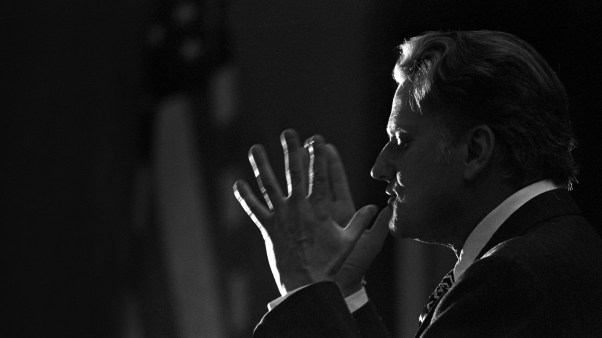The American culture is involved with two Christmas stories, each of which has had a great influence on our society. The one, the story of the birth of Christ, leads men to God. The other, the story of Santa Claus, confuses men about God.
As a pastor I deal with people who have difficulty understanding God. In general terms these people: (1) cannot conceive of God as a personality who is vitally interested in them as individuals, (2) have great difficulty in grasping the concept of living by faith, and (3) are not convinced that God means what he says. These attitudes form a common concept in which God is viewed as a distant, unconcerned, and harmless being who sends good and bad unexpectedly but is unable or unwilling to be of real help during a crisis. God threatens man with hell and judgment only to keep him in line in this life, but he will accept all men in one way or another in the end.
How strikingly parallel is this description of God to the nature of Santa Claus! It may be argued that Santa Claus is simply a reflection of the secular concept of God. Thus the Santa Claus story encourages a false view of God during the impressionable years of early childhood. Understanding this helps one understand secular man’s difficulty in relating to the living God revealed by Jesus Christ.
Santa Claus as God? Listen to the song children sing each Christmas.
You better watch out, you better not cry,
Better not pout, I’m telling you why—
Santa Claus is coming to town!
He’s making a list and checking it twice,
Gonna find out who’s naughty and nice—
Santa Claus is coming to town!
He sees you when you’re sleeping,
He knows when you’re awake,
He knows if you’ve been bad or good—
So be good for goodness’ sake!
Oh! You better watch out, you better not cry,
Better not pout, I’m telling you why—
Santa Claus is coming to town!
When asked, “Can Santa really see me through these walls?,” how does a parent reply? If he says, “Yes, Santa can really see you,” the parent is no longer operating on the level of healthy imagination; he is giving his words the ring of reality. The mythical becomes real for the child. Santa Claus can see and know a child’s behavior, rewarding him on the basis of that behavior; he can leave presents in every home the world over in just one night; he has reindeer that can fly.
Time moves on. The child begins to see flaws in this god-like person and in his parents’ attempt to maintain the deception. What he is told about Santa becomes less convincing; he may suspect that his parents are putting him on. For the most part the child will not mind playing the game, for he is well rewarded for his faith. When the parents finally drop the deception, it is revived fifteen or twenty years later by this child for his children. He wants them to experience the excitement and joy he remembers so well, and the process starts all over.
What does the child learn from the Santa Claus myth about a transcendent being? It may be one or all of the following, each of which hinders an adult’s ability to grasp the reality of God.
1. The child’s acceptability. The child learns that Santa keeps a record of his behavior, and that he can be acceptable to Santa by being good. If Santa is pleased, the child will be rewarded with presents. If Santa is not pleased, according to tradition the child will receive cinders and ashes. The way to be acceptable in Santa’s sight, then, is to be good.
2. Santa’s word. As Christmas morning approaches, the child is well aware of Santa’s warning and of his own behavior. He has not been perfect, and he knows it. Yet though he may feel some anxiety, he remembers last year and confidently awaits Santa’s return. And sure enough, on Christmas morning his faith in his own goodness is rewarded again. Thus he may conclude two things. First: He is okay as he is. His behavior, though not perfect, is acceptable to Santa. Second, Santa must not really mean what he says about children who cry or pout, for he gives gifts anyway. No matter what Santa says or what the child does, in the end Santa will reward him.
3. Santa’s presence. Santa visits his people once a year, spending the other 364 days in obscurity. The child may write him at the North Pole, but beyond that the communication is only one way: Santa secretly watching and recording the child’s behavior. Santa is not seen as one who is involved with daily living. A child learns to cope with his problems without expecting the help of the transcendent.
4. Santa’s activity. What does Santa do the rest of the year? He is busily engaged in a nice though rather meaningless activity, making presents. He exists somewhere up north as a harmless, friendly old man with a long white beard.
5. The child’s faith. As the child hears the story presented to him by society and his parents, he believes it. As far as he knows he is being told the truth. Why should he expect other than the truth from his parents? Gradually, however, the child begins to discover that his parents are playing a game with him—a nice game, but a game. As a result he devaluates his parents’ witness to the transcendent. The deception about Santa means the parent knew better all the time. Sadder but wiser, the child learns not to give credence to a way of life that demands faith, for who wants to make the same mistake twice?
Two lessons are apparent. First, Christians should not be surprised that secular man has a deep misunderstanding of the true nature and presence of God. Unless he has later been exposed to the truth of the Word of God, his most meaningful experience with the transcendent has been the Santa myth. He has left behind the outward form of the myth as a pleasant experience of childhood but has yet to find any other understanding of the supernatural.
Second, as Christians we need to be aware of the possible results of an indiscriminate use of the Santa Claus myth with children, especially if it is treated as other than a myth. Contrary to popular opinion (even in the Church), Christians will not spoil Christmas by omitting Santa Claus; rather, they will increase the child’s joy. For not only will Christian parents give the child the birthday of Jesus as the reason for Christmas, but they will make Christmas the basis for the child’s ability to trust God in his later life.
No doubt the American culture will continue to keep the Santa myth alive and well. It is up to the Christian who is concerned for the spiritual health of his children to do otherwise. Christ must be emphasized; Christmas is his birthday. He has come as a gift from God to show love, care, and concern for man—365 days a year. Leave Santa Claus for the realm of myth and fairy story. The earliest information about the transcendent that the child receives should be the true story of Christ, not the myth of Santa.
Samuel A. Mateer is minister of Altadena Valley Presbyteraian Church in Birmingham, Alabama. He received the B.D. from Fuller and the Th.M. from Princeton Seminary.










